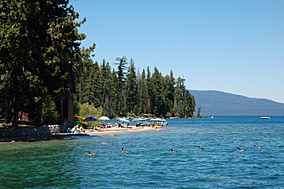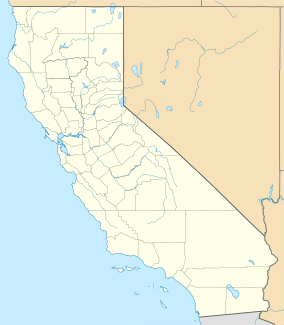Ed Z'berg Sugar Pine Point State Park facts for kids
Quick facts for kids Ed Z'berg Sugar Pine Point State Park |
|
|---|---|

|
|
| Location | El Dorado County, California |
| Nearest city | Tahoma, California |
| Area | 1,000 hectares (2,500 acres) |
| Established | 1965 |
| Governing body | California Department of Parks and Recreation |
|
Ed Z'berg Sugar Pine Point State Park
|
|
| NRHP reference No. | 73000401 |
| Added to NRHP | March 30, 1973 |
Ed Z'berg Sugar Pine Point State Park is a beautiful state park in California. It sits right on the western shore of Lake Tahoe, stretching for almost two miles. The park covers about 2,500 acres of forested mountains in El Dorado County, California. It used to be called Sugar Pine Point State Park. In 2003, its name changed to honor Edwin L. Z'berg. He was a California politician who worked hard to protect nature and create state parks.
Contents
Discover the Park's Nature
This park is located high up in the Sierra Nevada mountains. It sits at an elevation of about 6,200 feet (1,900 meters). The area is covered in a mixed forest of cone-bearing trees. You can find many types of trees here. These include Jeffrey pine, white fir, Sierra lodgepole pine, California incense cedar, sugar pine, and red fir.
Forest Life and Changes
In the fall, you'll see beautiful colors from trees like black cottonwood and quaking aspen. This forest has changed over time. In the late 1800s, a lot of trees were cut down. The wood was used by miners in places like the Comstock Lode.
For many years, people stopped natural wildfires. This changed how the forest grew. Now, park rangers use "controlled burns." These are small, planned fires. They help prevent very large, destructive wildfires.
General Creek and Its Path
The park is split by General Creek. This stream is about 9 miles (15 kilometers) long. It flows from the Desolation Wilderness right into Lake Tahoe. If you walk the General Creek Trail, you'll see lakes and mountain meadows. These meadows are full of wildflowers. You'll also spot two large moraines, which are hills left by ancient glaciers. The trail goes beyond the park into Eldorado National Forest.
Weather in the Park
In the summer, the temperature usually reaches about 80°F (27°C). Nights are cooler, around 40°F (4°C). Winter days are about 40°F (4°C), and nights can drop below 0°F (-18°C). The park gets about 32 inches of rain and snow each year. Most of this falls as snow in the winter.
A Look Back: Park History
The land where the park now stands was once home to the Washoe people. They would spend their summers by the lake. You can still find their stone mortars in the park today.
Early Settlers and Grand Estates
The first white settler here was a trapper named William "General" Phipps. He built a cabin in 1860, and it's still standing!
In 1903, a rich banker from San Francisco named Isaias W. Hellman bought land here. He built a grand house called Pine Lodge. It's also known as the Hellman-Ehrman Mansion. The house was designed by Walter Danforth Bliss. It had modern features like electric lights, indoor plumbing, and water piped directly from the lake. The estate also had a tennis court, two boathouses, and cabins for the 27 staff members who lived there.
The Hellman family spent their summers at the estate for many years. They sold it to the state in 1965, which is when the park was created. The family still helps fund the upkeep of the mansion and its property.
Olympic Connections
The 1960 Winter Olympics were held nearby at Squaw Valley Ski Resort. Some of the events, like the biathlon and cross-country skiing, took place right here in what is now the state park. Every January, the park and nearby towns celebrate Olympic Heritage Celebration Week. This remembers the exciting events from 1960.
Fun Things to Do at the Park
Ed Z'berg Sugar Pine Point State Park is special. It's the only California state park in the Sierra Nevada that stays open for winter activities.
Winter Fun
There are 11 miles of trails for skiing and snowshoeing. Some of these trails were even used in the 1960 Olympics! Some snow paths are smoothed out by machines. Park rangers sometimes lead guided snowshoeing tours. You can also go camping in the winter. Many more campsites open up for the summer season.
Summer Adventures
In the summer, you can enjoy swimming and other beach activities. Fishing is popular, and there are many great hiking trails. The park also has a nature center. Here, you can learn more about the park's plants, animals, and history.



